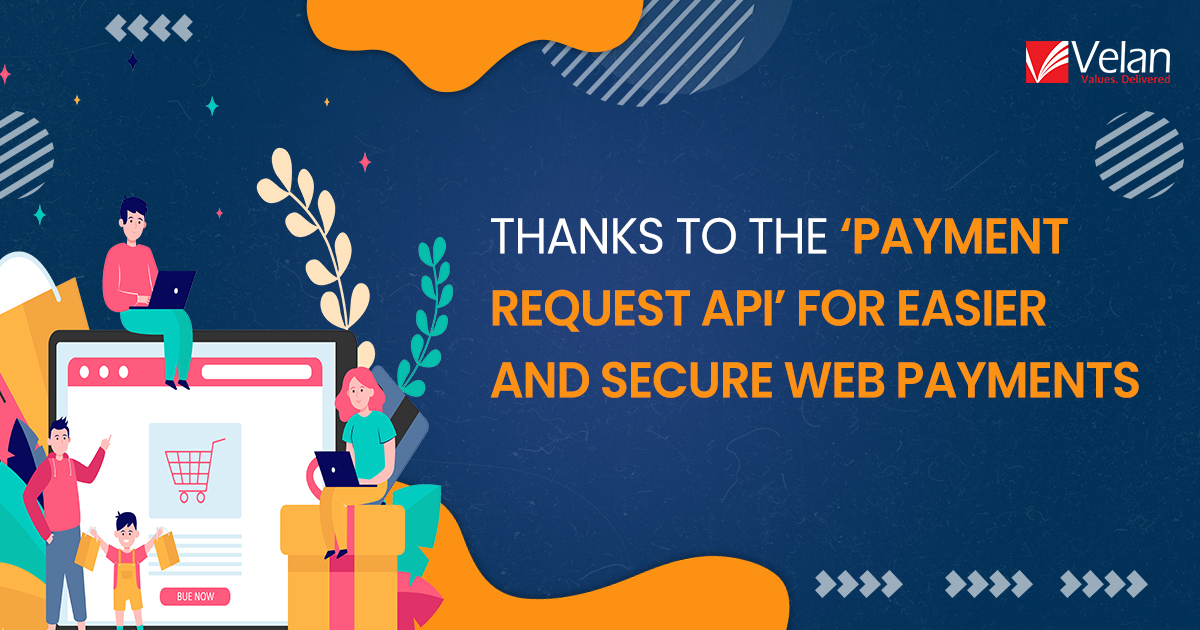Thanks to The ‘Payment Request API’ For Easier And Secure Web Payments 7 Jul 2021

Shopping online is if not always, most of the time a happy experience. You get to buy new things from the comfort of your couch at online stores. Earlier, it was through your laptop, and now, mobiles are one of the most used devices for online shopping. Thanks to the beautiful mobile devices, online stores are booming.
As much as online shopping brings one happiness, it can be equally annoying if the billing process gets longer and complex, especially on the palm-fitting handset. There are a lot of things that an eCommerce company has to look at if they want to build a mobile-friendly eCommerce website. From a great design to giving a smooth user experience, and making navigation through different pages simple, and above all, giving a seamless checkout out process, a lot is riding on it. The billing process is, by far, one of the top-rated reasons why users end snap off at the last moment. Keying in contact details, shipping, and delivery addresses, card details, making online payments, and confirming all the details as a final step is really tiresome for the customers. It is not how it works in a physical store. If you have given up your online shopping because of the laborious process you just read about, then you are in the predominance.
As expected, the abandonment rates on mobile are worse.
Recent data from the Baymard Institute calculated that seven out of every 10 shoppers abandoned their shopping carts, leaving the abandonment rate high up to 85.65 percent. The smaller screen and lesser typing space make the input slower. These abandonment rates are not a healthy sign for eCommerce business owners.
With regards to the impact on revenue, it is quite alarming at $18 billion annually.
Thankfully, the “Web Payments” W3C Working Group is fighting back. They have brought a revolutionary change in the web payment mode, building new standards to make online payments simple and straightforward.
The team designed an API with the goal of standardizing communication across browsers, merchants, and different payment types to provide a seamless user experience and a single, reliable API for developers.
Payment Request API
The first of these mighty standards, the Payment Request API, is a revolutionary change.
The goal of the Payment Request API is to mitigate the number of steps required to complete a checkout process. It gives the gateway for the online stores to request payment from the user. The user needs to enter their personal details and card information just once, and the browser will prompt a notification requesting to save the details. Once the details are saved, the Payment Request API remembers the user’s details and then passes on the user directly to the payment merchants to complete the payment. So, the next time when the user wants to make an online payment, the Payment Request API will retrieve the saved information and pass it on to the user directly to the payment approval screen bypassing the payment checkout form. Almost, all the browsers today support this revolutionary feature, thus making the online shopping experience a pleasant and easy one.
Payment Flow
Payment Request API allows a formless or nearly formless check-out experience.
For example, the API supports a “basic card” payment flow that enables the users to use payment card information stored in their browser. This process will make the check-out easier with just a couple of taps.
It will be beneficial for mobile phone shoppers. however, it will support any browser regardless of device.
The payment flow will look like this:
- Touch the buy button,
- Choose from the saved payment card on the browser,
- Key in the card’s security code, a.k.a. CVV code,
- Tap to complete the transaction.
The API-enabled transaction works as follows. The eCommerce website will begin the payment request. The browser will then handle the checkout that contains the care details and contacts the card payment processor. The browser, in turn, will return a token and customer information, like the shipping address, in JavaScript Object Notation (JSON) format.
The Payment Request API can also establish a connection with native payment applications, like Google Pay, Apple Pay, Phonepe, Pay Pal, and others.
For such native payment apps, a second API, known as the Payment Handler API, works with Payment Request API to seamlessly move the user from the eCommerce website to the payment application and back again.
In most cases, the shopper will not key in any information. This indicates the payment flow will be formless.
In every payment flow, the number of steps taken by a shopper and the amount of information entered by the shopper is drastically reduced when compared with a form-based check-out.
In other words, the check-out process should increase conversions by taking relatively less time and typing.
Security
The Payment Request API is, by far, the most secured payment method. They are based on encryption via tokens, known as cryptography. There is no need for the shopper to input the payment data, which can be logged or noticed at the point of entry.
Besides creating a seamless check-out experience, the modern approach is also better at shielding the payment details.
Furthermore, the browser renders a response token to the eCommerce application or the website. This makes the shopper’s payment card information safe and is not shared with the merchant. The eCommerce website will not receive, transmit, or record any payment card information. This will mitigate the seller’s scope and have zero relation to the Payment Card Industry’s Digital Security Standards.
Integration
Almost all the major eCommerce platforms, across the world, like Amazon, Flipkart, eBay, Alibaba, Groupon, etc, have integrated the Payment Request API or have a payment setup based on this API.
Innovation
Payment Request API has gained remarkable traction and has fueled innovation in the eCommerce industry.
For example, it has enabled the new in-app eCommerce experiences and motivates businesses to use applications and websites pertaining to the latest technology. The security is made stronger, and user experiences are made more seamless than before. It takes less than 120 seconds to complete the payment check-out.
Benefits of using the Payment Request API with card-based payments:
- Quicker purchase experience: The users no longer have to fill in the same details repeatedly across various websites. Once the browser stores the details, it will prompt to retrieve the saved information every time the user wants to pay online.
- Customized experience on all websites: The payment form is controlled by the browser and so, it will provide a consistent experience across all the websites that support API options. From selecting the preferred language to defaulting the addresses, the browser can provide customized experiences.
- Ease of access: The payment details input is controlled by the browser. Hence, the browser will take care of the accessibility options like font size adjustment, color contrast, keyboard accessibility, screen reading, etc., for the user based on the device they are using.
- Credentials management: The browser will handle the credit card and shipping address information of the user. It can also “sync” the credentials across all the devices based on the user account making it easy for the users to jump between devices for making payments.
- Constant error handling: The browser can validate the card numbers, and display if the card is valid or not. Besides, the browser can automatically recommend which cards to use based on the information from the payment merchant (for e.g, “we only accept Visa or Mastercard”), and also give the option to the user to “favorite” a card.
Role of Velan
Velan has been one of the most regarded eCommerce outsourcing companies for clients worldwide. We recommend the latest platform, Magento for our clients to introduce their online store. From providing complete Magento support to completing the service with a great customer support team, we cover it all for our client’s online stores.
We understand the significance of a payment gateway and the influence it has on the security and sales of a business.
Our key processes include:
- Conduct extensive research with key priorities. Check the PCI [Payment Card Industry] compliance of your potential payment solution to guarantee its security. We always scour for per-transaction prices to understand how a gateway will impact your bottom line.
- We hear your needs. Even if you don’t have a payment gateway yet, we will get specific insights that you may already have and failed to notice. We understand your customers’ shopping patterns and preferences before making the final call.
- We stack multiple gateways to address the gaps. This will guarantee to address maximum coverage for most of your customer needs.
- We help you decide the best gateway that will a front and back-end API. It will also have utmost security where the API sends card data directly and shares only secure token data back to the merchant.
With a thorough knowledge of the gateway functions, security, and price, we will elevate your business by providing the best eCommerce outsourcing services with guaranteed security.





